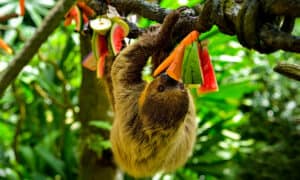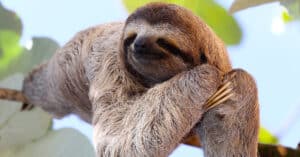Sloths are fascinating animals that have unique behavioral characteristics. They are known for their slow, deliberate movements and unusual sleeping patterns. Although sloths are primarily nocturnal creatures, this rule has some exceptions. Some species, such as three-toed sloth, can be nocturnal, diurnal, or cathemeral (active day and night). Regardless of their waking hours, however, all sloths show an affinity for rest and sleep. Overall, sloths’ unusual sleep behavior can tell us a lot about how they live and adapt in the wild.
What Are Sloths?
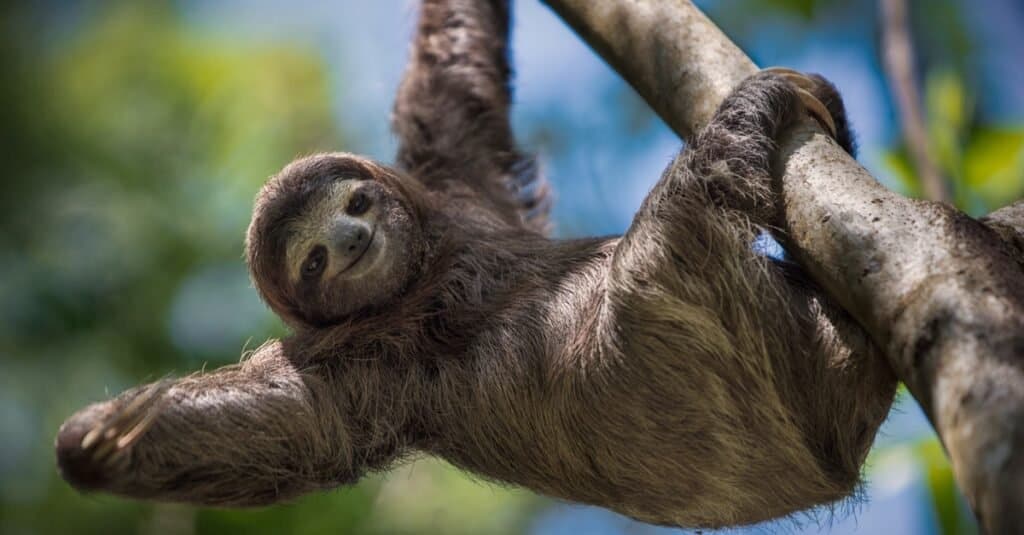
Sloths are mammals that belong to the taxonomic order of Pilosa.
©jdross75/Shutterstock.com
Sloths are strangely iconic creatures. Their characteristic slow movements and long, shaggy fur have become a symbol of pleasant laziness in our culture. But what are sloths, and from where do they come?
Sloths are mammals that belong to the taxonomic order of Pilosa. Their closest relatives are armadillos, anteaters, and several extinct South American mammals. You can find them inhabiting tropical forests throughout Central and South America, from southern Mexico down to northern Argentina. Within this extensive range, sloths inhabit various habitats such as rainforests, mangrove swamps, scrublands, cloud forests, and lowland forests.
Sloth Species Can Be Nocturnal, Diurnal, or Cathemeral
Currently, there is an estimation of six sloth species in existence. These species differ in their waking times and can be nocturnal, diurnal, or cathemeral. However, most sloths are nocturnal.
Most people are familiar with two types of sloth: the two-toed sloth and the three-toed sloth. At first glimpse, you might think that to tell sloth species apart, you should look at their forelimbs and the number of long, curved claws present. However, this is not the case, as several sloth subspecies have varying claw counts on both fore and hind limbs.
Some of the most well-known examples include Hoffman’s two-toed sloth and Linnaeus’ two-toed sloth, both of which have just two claws on their front limbs. Three-toed sloths have three claws on all four limbs; these include the pygmy three-toed sloth and the maned three-toed sloth. Both these sloth species are nocturnal. However, one study confirms that three-toed, brown-throated igapó sloths are cathemeral.
Sadly, the maned three-toed sloth (diurnal) and pygmy three-toed sloths (nocturnal) are considered vulnerable or critically endangered.
How and Where Do Nocturnal Sloths Sleep?
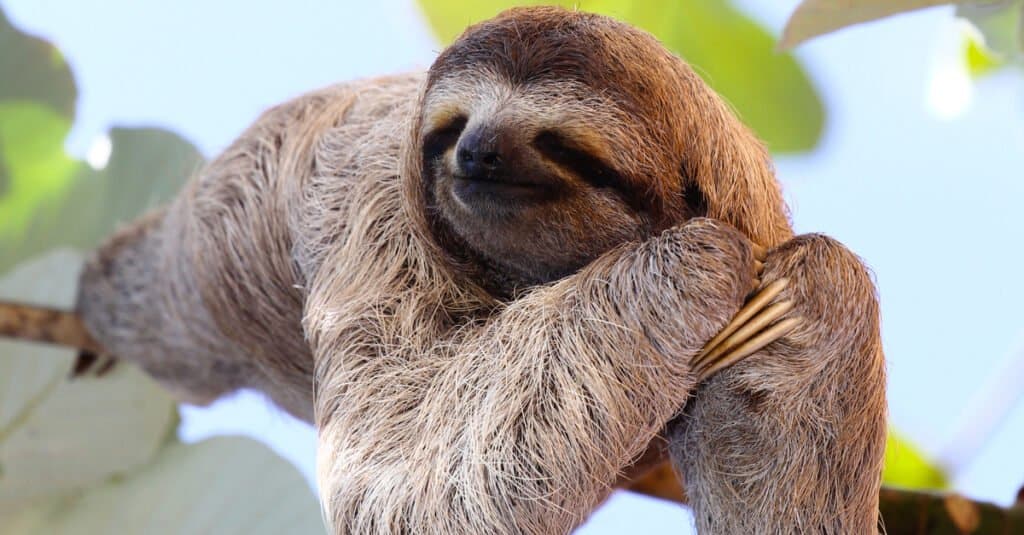
Sloths have poor hearing and rely on their sense of smell and touch to find food.
©Janossy Gergely/Shutterstock.com
True to their name, nocturnal sloths sleep for about 15 hours each day, typically spending their daylight hours resting in thick trees and becoming active at night. Sloths sleep for an impressive amount of time each day in shaded places. This behavior helps maintain a stable body temperature which they cannot regulate themselves.
Interestingly, their fluctuating temperature accompanies a slow metabolic rate and is the reason sloths move slowly through the trees to conserve energy. Overall, the unusual sleep behavior of sloths reveals just how complex and specialized their bodies are.
Do Sloths Sleep Upside Down?
Many wonder whether sloths sleep upside down in their characteristic hanging posture. While this may seem to be the case, there may be more to this behavior than meets the eye. According to recent research, the position of sloths’ digestive tracts and other anatomical features play a crucial role in determining whether they sleep upside down or not.
Other influencing factors seem to be gravity and the density of the food in the sloth’s stomachs (they have four). Considering all these factors, sloths seem to hang upside down primarily when moving and feeding. Consequently, it appears that when sloths are sleeping, they remain upright, consistent with previous observations about their behavior.
Overall, it seems clear that there is much more to the story of whether or not sloths sleep upside down than we might have initially suspected.
What Do Sloths Do at Night?
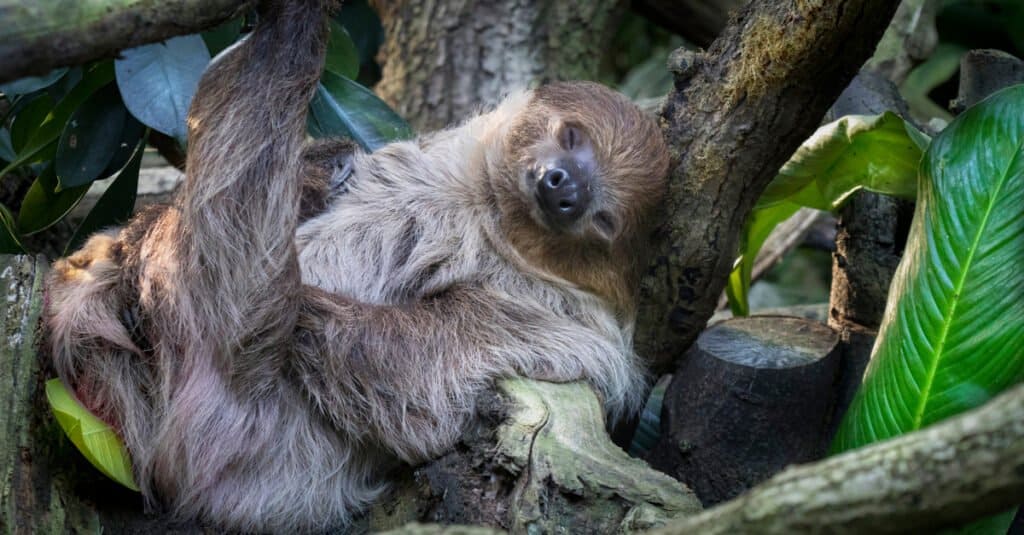
Captive sloths typically sleep much longer than wild sloths, who typically do not rest for more than 10 hours.
©milan noga/Shutterstock.com
At night, nocturnal sloths move through their habitat in search of food. These arboreal creatures are exceptionally skilled at navigating the dense canopy of trees and branches high above the ground. They can easily reach into these otherwise inaccessible areas using their long claws and extract the leaves and other plant matter that make up their diet.
Are Sloths Blind?
Many people are curious about whether sloths are blind. Research suggests that sloths have very poor eyesight due to a rare condition called rod monochromacy. This condition means that sloths lack cone cells in their eyes and are thus entirely color-blind. However, other studies indicate that although sloths cannot see in bright light, they still possess some degree of vision in dim conditions.
What Adaptions Do Sloths Have to Facilitate Nighttime Activity?
Sloths compensate for their poor vision with an impressive array of tools to help them get by. They have an excellent memory for spatial information and possess an extraordinary sense of smell. These adaptions enable them to navigate within the trees at night, even if they cannot rely on their sight as much as most other animals can.
What Factors Influence Sleep Behavior?
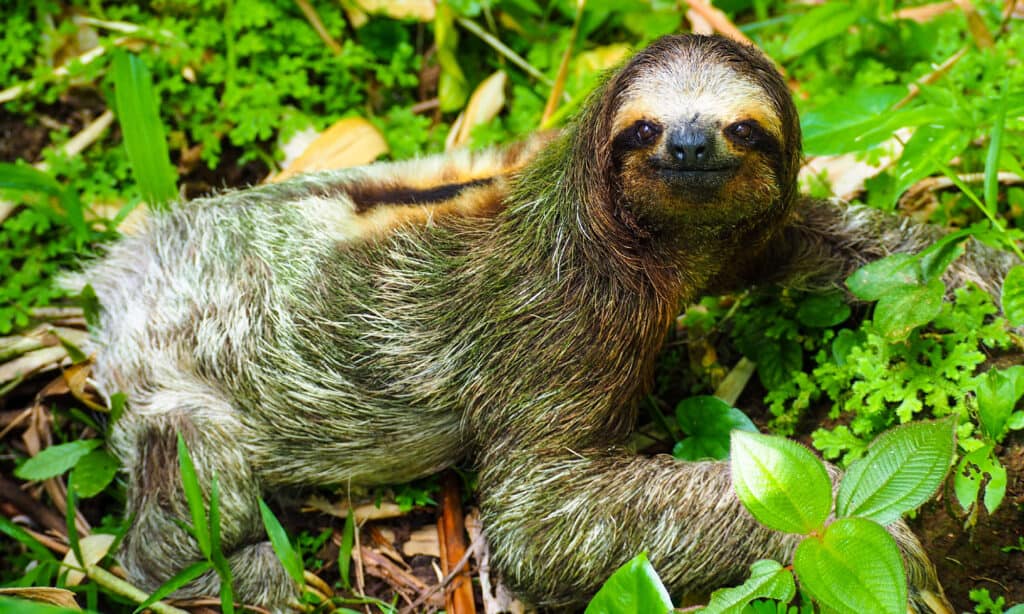
Island sloths may sleep more during their preferred daytime hours due to lower predation risk.
©Kristel Segeren/Shutterstock.com
Predation is a significant factor in the sleeping behavior of sloths, impacting both the timing and the amount of time they spend asleep. In research on sloths that sleep in the wild, it is apparent that different environmental pressures lead to other sleep patterns. For example, mainland sloths prefer to sleep at night. Their natural nocturnal predators, such as cats, are more active and likely to be awake. In contrast, island sloths may sleep more during their preferred daytime hours due to lower predation risk.
Despite this variation in timing, however, predation does not seem to impact the total sleep sloths get. Rather than seeking longer or shorter periods of rest under different conditions, they appear to adapt their sleeping schedule. This adaption helps them remain alert while minimizing their exposure to potential predators.
Another possible reason for this variation in sleep cycles may be genetic differences between individuals. Another could be environmental factors such as climate or temperature. Regardless of the underlying cause, predation plays a crucial role in shaping the sleeping behavior of these intriguing animals.
Ecosystems Rely on Sloths
While sloths may seem like sleepy little creatures, it is essential to remember that there is far more to these fascinating animals than meets the eye. Sloths may be famous for their sluggishness, but they play a vital role in the ecosystem. They maintain healthy tropical areas by dispersing seeds and helping to balance plant populations through their feeding habits.
Besides these fascinating facts, sloths have another peculiar characteristic. The hair on their bodies is specifically designed to encourage the growth of epibionts such as fungi and algae growth. This growth creates a symbiotic relationship, giving plant matter a space to thrive and giving sloths extra camouflage. When you move so slowly, you need all the help you can get to survive.
So, if you see a sloth slowly ambling along, take some time to admire these charming little creatures. They are so much more than their sleepy exterior suggests. One thing is for sure: these unique and fascinating creatures continue to hold many mysteries to explore and from which to learn.
Nocturnal vs. Diurnal: What’s The Difference?
Navigate to Nocturnal vs. Diurnal: What’s The Difference? for further information about the nocturnal and diurnal phenomenon in various living creatures.
Up Next –
- Are Sloths Dangerous?
- Sloth Poop: Everything You’ve Ever Wanted to Know
- New Study: Giant Carnivorous Sloth Once Roamed the Earth
- Why Did the Giant Sloth Go Extinct?
The photo featured at the top of this post is © iStock.com/Parkol
Sources
- John Wiley & Sons, Available here: https://onlinelibrary.wiley.com/doi/full/10.1111/brv.12773
- Canadian Science Publishing, Available here: https://cdnsciencepub.com/doi/abs/10.1139/cjz-2020-0177?journalCode=cjz#:~:text=We%20concluded%20that%20igap%C3%B3%20sloths,factors%20influencing%20their%20activity%20pattern.
- John Wiley & Sons, Available here: https://onlinelibrary.wiley.com/doi/abs/10.1111/j.1365-2907.2004.00039.x
- National Library of Medicine, Available here: https://www.ncbi.nlm.nih.gov/pmc/articles/PMC4044746/
Thank you for reading! Have some feedback for us? Contact the AZ Animals editorial team.



